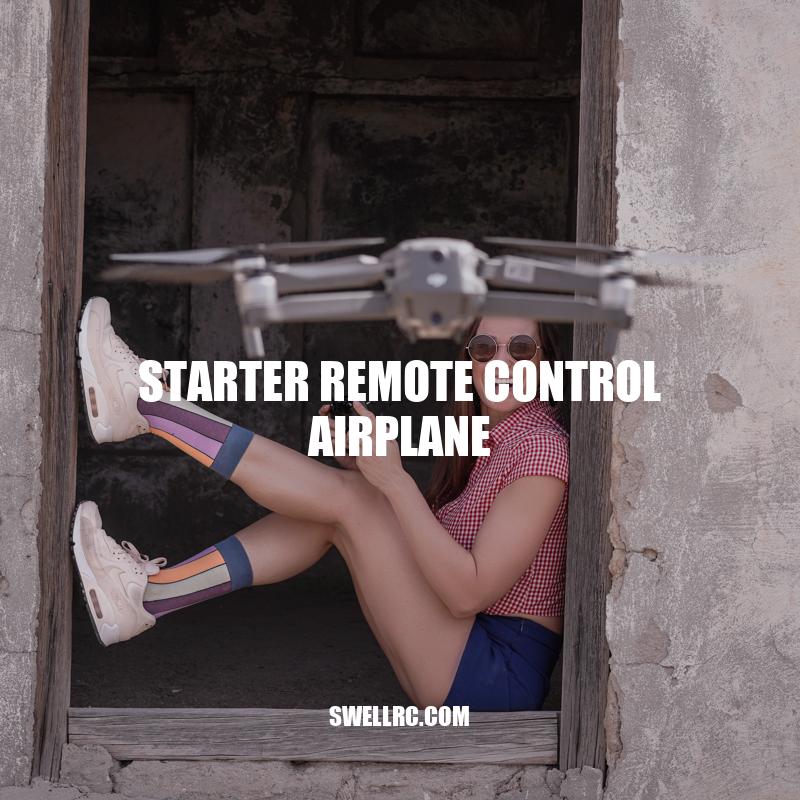Beginner’s Guide to Starter Remote Control Airplanes
Remote control airplanes have become increasingly popular among hobbyists in recent years. These small, lightweight aircraft can be flown for fun or used for aerial photography and other purposes. For someone who is new to the hobby, beginning with a starter remote control airplane can be a wise choice. These models are designed with ease of use in mind and are typically less expensive than higher-end models. Choosing the right model and learning the basics of flying can be challenging, but with a little practice and patience, beginners can master the art of remote control flight. In this article, we will provide tips and advice for those interested in starting their journey in this exciting hobby. From selecting the right components to flying safely and maintaining the airplane, we will cover everything you need to know to get started with your first remote control airplane.
Beginner Models
If you’re new to the hobby of Starter Remote Control Airplane, it’s important to start with a model that’s designed for beginners. Here are some factors to consider when choosing a beginner model:
- Electric vs gas-powered: Electric models are lighter, easier to maintain, and less expensive, making them a better choice for beginners.
- Ready-to-fly (RTF) vs. Build-your-own: RTF models come fully assembled and ready to fly straight out of the box. Build-your-own models require more time and effort to put together but can teach valuable skills.
- Wingspan: Shorter wingspans are easier to control and maneuver but may be less stable in windier conditions. Longer wingspans are more stable but may be harder to control.
- Price: Beginner models can cost anywhere from $50 to $500. While it can be tempting to go for the cheapest option, it’s important to invest in a model with good quality components and features that will last.
There are many websites dedicated to remote control airplanes that offer detailed reviews and comparisons of different models. Some popular options include RCGroups.com, FliteTest.com, and HorizonHobby.com. Be sure to do your research and read customer reviews before making your purchase.
Is RC planes an expensive hobby?
Yes, RC planes can be an expensive hobby. The cost of RC planes can range anywhere from $50 to over $1000, depending on the type and quality of the plane. In addition to the cost of the plane, there are also other expenses to consider such as batteries, chargers, controllers, and replacement parts.
However, there are ways to reduce the cost of RC planes as a hobby:
- Buy used planes or kits from online marketplaces or hobby shops.
- DIY planes from scratch or from kits instead of purchasing pre-built planes.
- Participate in online forums and communities to learn about beginner-friendly and affordable planes and accessories.
It is important to remember that investing in a quality RC plane can result in a longer-lasting and more satisfying hobby experience. Websites such as Horizon Hobby and HobbyKing offer a range of RC planes and accessories at varying price points.
Components of a Starter Remote Control Airplane
Before taking your starter remote control airplane out to fly, it’s important to understand the essential components of the aircraft and how they work together. Here are the main components of a starter RC airplane:
| Component | Function |
|---|---|
| Motor | Propels the plane forward and generates lift for takeoff. |
| Battery | Powers the motor and flight control system. |
| Receiver | Receives signals from the remote control and translates them into commands for the airplane. |
| Transmitter | The handheld device used to control the airplane’s movements. |
| Servo | Translates the commands from the receiver into motion of the control surfaces on the airplane (such as the elevator, ailerons, and rudder). |
| Airframe | The structure of the airplane that holds all the components together. |
Once you have a basic understanding of the components, it’s important to select the right parts for your beginner model. Most starter models come with all the necessary components included, but you may want to upgrade certain parts (such as the battery or motor) for better performance. Many online RC airplane retailers offer upgrade packages specifically designed for beginner models that can improve performance without breaking the bank.
What parts do you need for an RC plane?
To build an RC plane, you will need the following essential components:
| Required Components |
|---|
| Remote Control Transmitter and Receiver |
| Motor and ESC |
| Battery and Charger |
| Servo Motors |
| Propeller |
| Control Surfaces (elevator, rudder, ailerons) |
Other additional components that could be used for specialized builds include:
- FPV and Camera gear
- Gyros and Stabilizers
- Landing gear
- LED lighting
- etc.
If you’re looking for parts to build an RC plane, you can check out websites like HobbyKing, Motion RC, or Amazon.
Safety Precautions
Flying remote control airplanes can be a fun and exciting experience, but it’s important to prioritize safety. Here are some tips to keep in mind before flying your starter remote control airplane:
- Always read the instruction manual carefully before operating the aircraft.
- Choose an open, unobstructed area to fly that is away from people, animals, and obstacles (such as buildings and power lines).
- Never fly near airports or other areas that are restricted for aircraft use.
- Wear eye protection when operating the aircraft.
- Keep the aircraft within your line of sight at all times. Do not fly the aircraft higher than you can see it.
- Avoid flying in windy or stormy conditions to prevent the aircraft from being blown out of control.
- Always follow the manufacturer’s recommended safety guidelines and FAA regulations.
In addition to following these safety precautions, it’s a good idea to invest in an emergency parachute system for your aircraft. These devices can prevent the aircraft from falling to the ground and causing damage or injury in the event of a malfunction. Several online retailers offer emergency parachute systems specifically designed for remote control aircraft, so be sure to do your research and purchase a system that is compatible with your specific model.
How do you fly a remote control airplane?
Flying a remote control airplane can be a thrilling experience, but it can also be challenging for beginners. Here are some basic steps to get you started:
- Choose a suitable flying location with enough space and minimal obstacles.
- Inspect your remote control airplane to ensure it is in good condition and all parts are properly secured.
- Power on the remote control and airplane, and ensure they are properly synced.
- Gradually increase throttle to attain lift-off.
- Use the remote control’s joysticks to control the airplane’s movements, including direction, altitude, and speed.
- When landing, gradually reduce throttle and guide the plane to the ground.
It’s important to note that flying a remote control airplane requires practice and patience. Consider joining a local model aircraft club or seeking guidance from experienced RC pilots.
If you’re in need of a quality remote control airplane, websites such as Horizon Hobby and Tower Hobbies offer a wide selection of options for all skill levels.
Flying Tips
Once you have selected your starter remote control airplane and familiarized yourself with its components and safety guidelines, it’s time to take to the skies. Here are some flying tips to help you get started:
- Start with short, low-altitude flights until you become more comfortable with controlling the aircraft.
- Practice making turns and climbs to get a feel for the airplane’s handling.
- Use small, subtle movements on the remote control to avoid over-correcting or making sudden movements that can cause the aircraft to crash.
- Practice landing on a soft surface, such as grass or sand, to minimize damage in the event of a hard landing.
- Experiment with different flight patterns, such as figure eights or circles, to improve your skills and keep flying interesting.
- Join a local club or find a community of remote control enthusiasts online to learn from more experienced pilots and get feedback on your flying technique.
Remember, flying a remote control airplane takes practice and patience. Don’t get discouraged if you struggle at first. Keep practicing and soon you’ll be soaring through the skies like a pro. For more information and to buy a starter remote control airplane, check out Horizon Hobby’s selection.
What helps with first time flying?
- Research the airport and airline ahead of time to ease anxiety
- Avoid caffeine and alcohol to stay calm during the flight
- Bring distractions such as books, music or games to pass the time
- Use noise-cancelling headphones or earplugs to block out any unwanted noise
- Consider purchasing travel insurance to protect against unexpected events, such as flight cancellations or lost luggage
Some websites that offer helpful information for first-time flyers include:
Maintenance and Storage
Proper maintenance and storage of your starter remote control airplane is important to ensure it stays in good condition and performs at its best. Here are some maintenance and storage tips:
- After each flight, check the airplane for any damage and clean it thoroughly to remove any dirt or debris.
- Store the airplane in a dry, cool place to prevent moisture and high temperatures from damaging the components.
- Remove the battery from the airplane and store it in a cool, dry place. If the battery is not used for an extended period, charge it up periodically to keep it in good condition.
- Check the components regularly for signs of wear and tear. Replace any damaged or worn components before flying.
Following these tips will help prolong the life of your setup and ensure that you can enjoy flying your remote control airplane for years to come. If you need any parts or accessories for your airplane, there are many online stores and retailers that specialize in remote control hobby supplies. Be sure to research reviews and shop around to find the best deals and products for your needs.
How do you store RC planes?
Storing RC planes properly is essential to keep them in good condition. Here are some tips for storing your RC planes:
- Store them in a cool, dry place with low humidity.
- Use a soft cloth to cover the plane to prevent dust accumulation.
- Remove the battery before storing the plane to prevent damage or leakage.
- Place the plane on a flat surface to avoid warping or bending.
- Hang the plane upside down if possible to prevent the wings from bending.
If you’re looking for storage solutions specifically designed for RC planes, you can check out websites such as Motion RC or HobbyKing for specialized carrying cases and storage bags.
Conclusion
In conclusion, flying a remote control airplane can be a fun and exciting hobby for people of all ages. Starting with a beginner-level model is a great way to learn the basics and gain experience before moving on to more advanced planes. Remember to prioritize safety while flying and follow local rules and regulations. Regular maintenance and storage of your airplane will help it last for many flights to come. With the information and tips provided in this article, you should be ready to take to the skies with your new remote control airplane. Happy flying!



